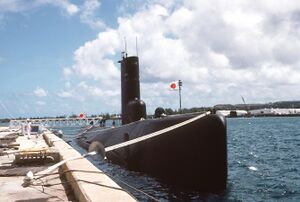Engineering:Asashio-class submarine
 Arashio alongside in Apra Harbor on 1 April 1984
| |
| Class overview | |
|---|---|
| Name: | Asashio class |
| Builders: |
|
| Operators: |
|
| Preceded by: | Ōshio class |
| Succeeded by: | Uzushio class |
| Built: | 1964−1969 |
| In commission: | 1966−1986 |
| Planned: | 4 |
| Completed: | 4 |
| Retired: | 4 |
| General characteristics | |
| Type: | Submarine |
| Displacement: | |
| Length: | 88 m (288 ft 9 in) |
| Beam: | 8.2 m (26 ft 11 in) |
| Draft: | 4.9 m (16 ft 1 in) |
| Propulsion: | |
| Speed: |
|
| Complement: | 80 |
| Armament: |
|
The Asashio-class submarine is a submarine class of Japanese Maritime Self-Defense Force comprising four boats. This class is the successor of Ōshio. The class were the first fleet submarines constructed for post-war Japan. The first submarine was authorized as part of the 1963 shipbuilding programme. Their design improved on previous Japanese classes by being larger to obtain better seaworthiness with greater torpedo stowage. The class entered service in the late 1960s and remained as such until the mid-1980s when they were taken out of service.
Design and description
Based on the preceding Ōshio, the Asashio class were of similar design but with a different shaped bow and improved sonar. They are considered the first fleet submarines constructed for Japan in the post-World War II era.[1] The submarines, constructed with a double hull,[2] measured 88 meters (288 ft 9 in) long with a beam of 8.2 m (26 ft 11 in) and a draft of 4.9 m (16 ft 1 in). The vessels had a standard displacement of 1,650 long tons (1,680 t) surfaced and a submerged displacement of 2,150 long tons (2,180 t).[1] The Asashio class had a complement of 80.[3] The Asashio class were propelled by two propellers powered by a diesel-electric system comprising two Kawasaki diesel engines creating 2,900 brake horsepower (2,200 kW) and two electric motors creating 6,300 shaft horsepower (4,700 kW). This gave the submarines a maximum speed of 14 knots (26 km/h; 16 mph) submerged and 18 knots (33 km/h; 21 mph) while surfaced.[3]
The vessels were equipped with eight torpedo tubes, six in the bow and two in the stern.[1][3] The sources disagree on the torpedo armament, with two sources stating that all eight were for 533-millimeter (21.0 in) torpedoes,[1][3] while another states that only the forward six were for the 533 mm torpedoes and the stern tubes were for 320 mm (12.7 in) torpedoes.[2] Moore[2] and Gardiner, Chumbley and Budzbon[1] state that the stern tubes were for "swim-out" torpedoes with Gardiner, Chumbley and Budzbon adding they were for anti-submarine warfare (ASW) and that the forward tubes were intended for US Mark 54 torpedoes.[1] They carried a total of 20 torpedoes.[4] The Asahio class mounted ZPS-3 radar, SQS-4 active sonar and JQS-3A and JQQ-2A passive sonars. They were also equipped with BLR-1 intercept equipment.[3]
Boats
| Asashio class construction data[1][2] | ||||||
|---|---|---|---|---|---|---|
| Pennant no. | Name | Builder | Laid down | Launched | Commissioned | Fate |
| SS-562 | Asashio (あさしお) | Kawasaki Shipbuilding Corporation | 15 October 1964 | 27 November 1965 | 13 October 1966 | Decommissioned 30 March 1983 |
| SS-563 | Harushio (はるしお) | Mitsubishi Heavy Industries | 12 October 1965 | 25 February 1967 | 1 December 1967 | Decommissioned 30 March 1984 |
| SS-564 | Michishio (みちしお) | Kawasaki Shipbuilding Corporation | 26 July 1966 | 5 December 1967 | 29 August 1968 | Decommissioned 27 March 1985 |
| SS-565 | Arashio (あらしお) | Mitsubishi Heavy Industries | 5 July 1967 | 24 October 1968 | 25 July 1969 | Decommissioned 27 March 1986 |
Construction and career
The first submarine Asashio was ordered as part of the 1963 shipbuilding programme.[2] Construction was split between the Kawasaki and Mitsubishi yards at Kobe. The submarines were used for ASW training for surface ships in naval exercises. The class was deleted in the mid-1980s.[1][4]
See also
- JDS Kuroshio - First submarine acquired by the JMSDF, via it being loaned by the U.S under the Military Assistance Program.
- JDS Oyashio - First naval submarine built in post-war Japan.
Citations
References
- Couhat, Jean Labayle, ed (1986). Combat Fleets of the World 1986/87. Annapolis, Maryland: Naval Institute Press. ISBN 0-85368-860-5.
- Conway's All the World's Fighting Ships 1947–1995. Annapolis, Maryland: Naval Institute Press. 1995. ISBN 1-55750-132-7.
- Moore, John, ed (1982). Jane's Fighting Ships 1981–82 (85th ed.). London: Jane's Publishing Incorporated. ISBN 0-86720-617-9.
- Moore, John, ed (1984). Jane's Fighting Ships 1984–85. New York: Jane's Publishing Incorporated. ISBN 0-7106-0795-4.
 |

